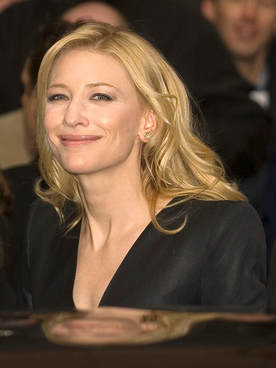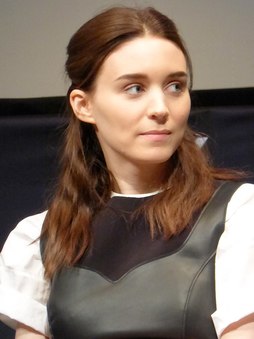|
by Marina Brafa It’s winter time again: the scent of cinnamon wafting through the air, the decorating of gingerbread houses and Christmas movies hitting theaters in a jingle-bell-like staccato. Ready for some nauseatingly kitschy Christmas staples? Or something new? For the second installment of our Cringe series, we are featuring the film Carol.  Cate Blanchett at Berlinale Film Festival (photo: Thore Siebrans) Cate Blanchett at Berlinale Film Festival (photo: Thore Siebrans) Most viewers would not think of Carol as a Christmas movie, despite the title. Its unconventional love story breaks the mould of genre conventions. Instead of a girl-meets-boy plot with a happy ending on Christmas Eve, we see two women, Carol Aird (Cate Blanchett) and Therese Belivet (Rooney Mara), falling in love with each other. Christmas, the loveliest time of the year and family fest par excellence, makes their special relationship and the problems that come with it abundantly apparent. A woman is supposed to be with her family on Christmas, but what happens when the family is falling apart? Carol is divorcing her husband Harge (Kyle Chandler) and fighting for the custody of her daughter; Therese has a boyfriend with whom she is not in love. However, both Carol’s husband and Therese’s boyfriend ignore the reality of the situation, grinning and bearing it. For them, Christmas is still the time to be together as a family. Haunted by Christmas conventions and traditions, Carol and Therese escape on a road trip to explore their feelings for each other. The two of them manage to get away from their families, but they cannot flee the times in which they live. It’s 1950s America and love between women is not only a taboo but unheard of (at least to those who won’t listen). Carol and Therese take a break from society’s expectations but they will be waiting for them at home. The two very different female characters uphold the adage that opposites attract. As the title states, we get to know Carol in depth, an ethereal woman with bright blond bombshell hair and garishly red shiny lips. She is in her 40s, married to a sleek businessman, yet she loves women. It’s a secret that everyone knows but no one dares talk about. On a December day, Carol ends up in a department store to find a Christmas gift for her daughter. That’s where she meets Therese. She is younger than Carol, with short brown hair and coy pink lip gloss. Her big innocent eyes follow Carol through the department store, not knowing what to make of this woman who had stared and smiled at her. It’s the beginning of a seductive love – and an unequal relationship between Carol and Therese.  Rooney Mara plays Therese. Her sister Kate Mara is known for her role as journalist in House of Cards season . Rooney Mara plays Therese. Her sister Kate Mara is known for her role as journalist in House of Cards season . Cate Blanchett plays Carol as a woman who took all steps on the path that 1950s society considered normal for women. Now, she is going against “normalcy,” which makes her both vulnerable and strong. In contrast, Rooney Mara gives Therese the aspect of an insecure woman at the very beginning of her social life. She is unsure about marrying her boyfriend and hates her job at the department store, wishing to be a photographer for The New York Times instead. Carol approaches her, Carol invites her for dinner, Carol takes her on a road trip. The whole story is primarily showing how Carol “helps” Therese discover her homosexuality. At one point, Carol leaves Therese. A turning point in their relation? No. Therese does start a new job but her thoughts are with Carol. While staring at the pictures she took of her, she mourns her loss. In the end, Carol reconnects with Therese, confesses her love and - after a short moment of withdrawal - Therese happily returns. In the last scene, we see Therese staring at Carol, the camera moves from Therese’s point of view toward Carol, capturing her half-closed eyes. Just like at the beginning at the department store. The film’s plot line is not really intricate. However, the feelings it tries to convey are, and they need time to develop. Director Todd Haynes (who is known for transcending and questioning conventional gender roles and racial stereotypes in his films) turns the movie’s screenplay by Phyllis Nagy into a two-hour epic. The slow-paced cinematography and reduced dialogue reflect the slow and cautious unfolding of emotions. Gestures and facial expressions – their eyes, their hands, their lips! – are more important than what the characters say. In one scene, Therese is at the cinema with some friends. One of them is “charting the correlation between what the characters say and how they really feel.” That’s Carol in a nutshell. The film should be applauded because it shows lesbian love (and the fight for its acknowledgement) on the big screen. The situation of homosexual women is still complicated in many societies worldwide but awareness is rising. Films such as Carol are part of this development. It is both the result of the mere fact that it could be made and fuel for a rising acceptance of female homosexuality. Because let’s face the truth: Cinemagoers are more used to seeing two men kissing each other than two women. Carol not only shows female friendship (one might think of Thelma and Louise) or subtly hints at something more than friendship, but rather presents female love explicitly. Don’t get me wrong: In 2018, a plethora of films exist about it, but how many of them have found their way into cineplex programs, thus reaching a larger audience beyond queer cinema? Reading suggestion: Carol’s screenplay is based on Patricia Highsmith’s 1952 novel The Price of Salt.
0 Comments
Leave a Reply. |


 RSS Feed
RSS Feed
